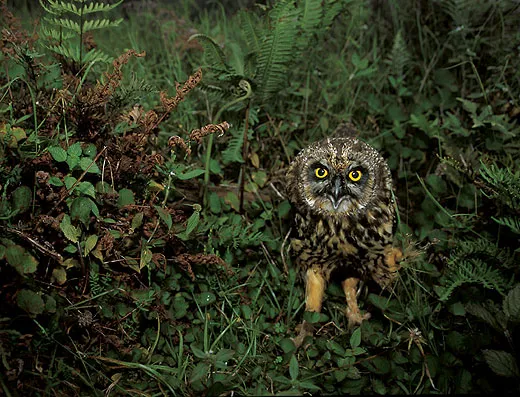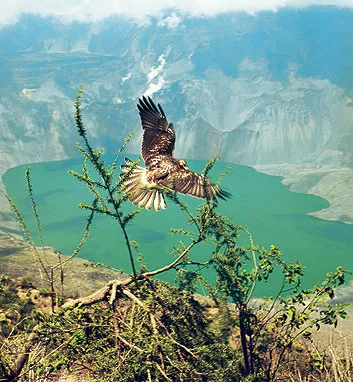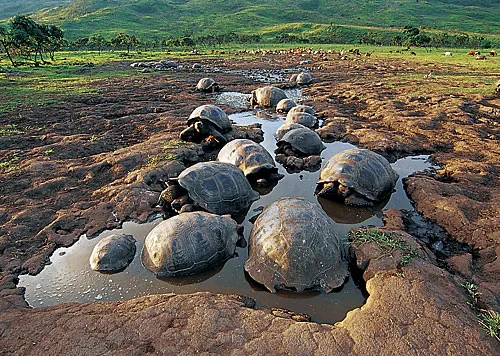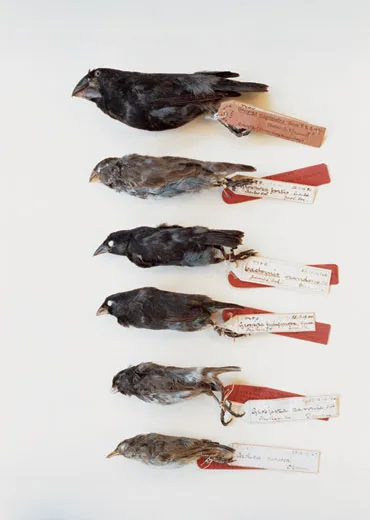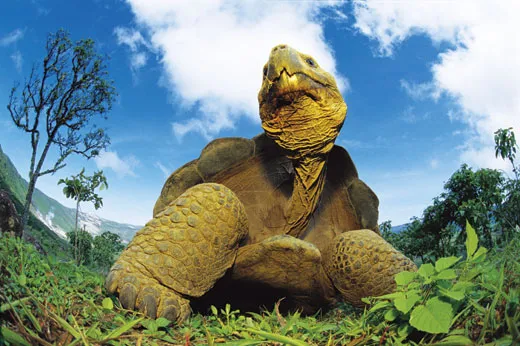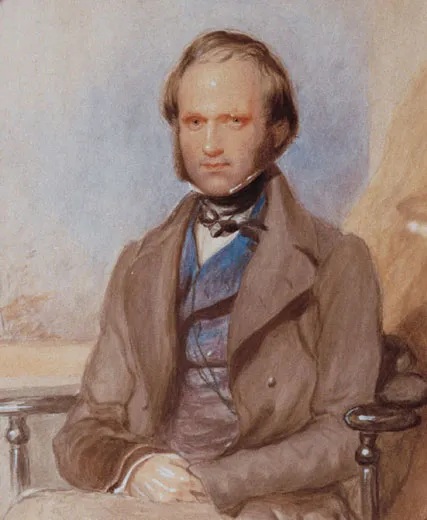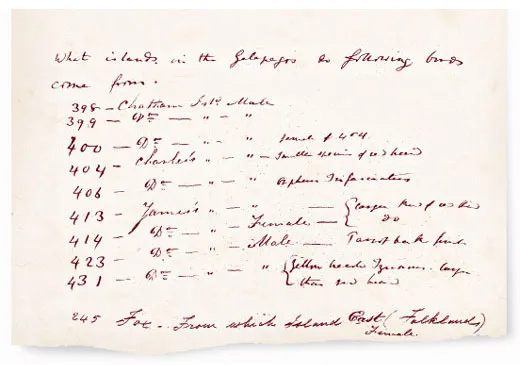The Evolution of Charles Darwin
A creationist when he visited the Galápagos Islands, Darwin grasped the significance of the unique wildlife he found there only after he returned to London
/https://tf-cmsv2-smithsonianmag-media.s3.amazonaws.com/filer/Charles_Darwin631.jpg)
From the nine times I have made the 5,000-mile journey to the Galápagos Islands, to follow in Charles Darwin’s footsteps, the most enduring impression I have gained is of life’s fragility. The minute a person steps off any of the tourist trails created by the Galápagos National Park Service and heads into the untamed interior of one of these islands, there is the risk of death under the intense, equatorial sun. On Santa Cruz Island, where the Charles Darwin Research Station is located, 17 people have disappeared since 1990. Most were subsequently found alive after having become hopelessly lost in dense underbrush and rugged volcanic terrain. But some perished. One was a young Israeli tourist who lost his way in Santa Cruz’s Tortoise Reserve in 1991. Amassive, two-month search failed to find him. In fact, some of the searchers themselves became lost and had to be rescued. In the end, fishermen discovered the young man’s body. A former Israeli tank commander, he had been in top physical condition, yet had managed to go only six miles before succumbing to the searing heat and lack of fresh water. A sign in the Tortoise Reserve says bluntly: “Stop. Do not go beyond this point. You could die.”
This is the deceptively treacherous world of sun-baked lava, spiny cactus and tangled brushwood into which Charles Darwin stepped in September 1835, when he reached the Galápagos Islands with fellow crew members of the HMS Beagle. The Beagle’s captain, Robert FitzRoy, described the barren volcanic landscape as “a shore fit for Pandemonium.” At 26, Darwin had come to the archipelago, which straddles the Equator some 600 miles west of Ecuador, as part of the Beagle’s five-year mission to survey the coast of South America and to conduct a series of longitudinal measurements around the globe. Darwin’s five-week visit to these remarkable islands catalyzed the scientific revolution that now bears his name.
Darwin’s revolutionary theory was that new species arise naturally, by a process of evolution, rather than having been created—forever immutable—by God. According to the well-established creationist theory of Darwin’s day, the exquisite adaptations of many species—such as the hinges of the bivalve shell and the wings and plumes on seeds dispersed by air—were compelling evidence that a “designer” had created each species for its intended place in the economy of nature. Darwin had wholeheartedly accepted this theory, which was bolstered by the biblical account in Genesis, until his experiences in the Galápagos Islands began to undermine this way of thinking about the biological world.
The Galápagos Islands were formed by volcanic eruptions in the recent geological past (the oldest of the islands emerged from the ocean just three million years ago), and Darwin realized that the remote setting must have presented life with a new beginning. “Seeing every height crowned with its crater, and the boundaries of most of the lava-streams still distinct, we are led to believe that within a period, geologically recent, the unbroken ocean was here spread out,” he wrote in his Journal of Researches. “Hence, both in space and time, we seem to be brought somewhat near to that great fact—that mystery of mysteries—the first appearance of new beings on this earth.”
How, Darwin asked himself, had life first come to these islands? “The natural history of these islands,” he later pointed out, “is eminently curious, and well deserves attention. Most of the organic productions are aboriginal creations, found nowhere else.” Yet all of the creatures showed a marked relationship with those from the American continent. The novel Galápagos species, Darwin reasoned, must have started out as accidental colonists from Central and South America and then diverged from their ancestral stocks after arriving in the Galápagos. As he traveled from island to island, Darwin also encountered tantalizing evidence suggesting that evolution was proceeding independently on each island, producing what appeared to be new species.
Other evidence, from the South American continent, showed that species did not seem to be stable across either geographic space or the deep reaches of paleontological time. But the particularly compelling evidence from the Galápagos Islands catapulted Darwin and life science into the modern age. He subsequently added to his daring endorsement of evolution the crucial insight that species evolve by means of natural selection: variants that are better adapted to their environments are more likely to survive and reproduce. When he finally published On the Origin of Species by Means of Natural Selection in 1859, Darwin’s revolutionary theories not only recast the study of life but also turned the Galápagos Islands into hallowed scientific ground.
More than three decades ago, I became fascinated by Darwin’s life, and especially by his historic voyage around the world. When evolutionary biologist Edward O. Wilson, whose undergraduate course I was taking at Harvard, learned of my interest, he suggested that I go to the Galápagos Islands, and he helped fund a documentary about Darwin’s voyage. My first trip, in 1968, was two years before the beginning of organized tourism in the Galápagos. Just getting to the islands
was a challenge. Our expedition flew from Guayaquil, Ecuador, in a PBY, an amphibious, twin-engine patrol plane dating back to the World War II era. We sat in seats made of mesh nets. There were numerous holes in the plane’s undercarriage, through which I could see all the way to the ocean below. The impression these starkly beautiful islands made upon me was indelible (the volcano that forms the island of Fernandina put on a spectacular eruption during our visit).
Eight expeditions later, I continue to be drawn to these islands in an effort to document their extraordinary impact on Darwin, as well as to study ecological changes since Darwin’s day. With the advent of organized tourism, much has changed. Now, two to four passenger planes fly each day to the Galápagos, bringing a total of about 100,000 tourists a year. Puerto Ayora, home to the Charles Darwin Research Station, is a booming tourist stop with a population of about 15,000 people, almost ten times the number that resided there during my first visit. As tourists enjoy their organized cruises around the islands, they are confined to 60 localities, carefully selected by the National Park Service, and are required to stay on clearly marked paths that keep them out of harm’s way.
Two main questions confront the student of Darwin’s historic visit: Where did Darwin go, and exactly how did his visit affect his scientific thinking? Answering the first turns out to be easier than one might think, thanks to a rich repository of documentary sources. The British Navy had a penchant for keeping detailed records, and the Beagle’s voyage is described in three ship’s logs, Captain FitzRoy’s personal narrative, a series of excellent maps made by the Beagle’s officers, and various watercolors and sketches by crew members. We are also able to draw on Darwin’s own extensive record of his dozen or so field trips, which encompasses more than 100 pages of unpublished notes and more than 80 pages of published material.
For five years the Beagle’s logs recorded, often on an hourly basis, where the ship was and what it was doing. Two days after the first sighting of land in the Galápagos, on September 15, 1835, the Beagle anchored in Stephens Bay on Chatham Island, now known as San Cristóbal. (All the islands were given Spanish as well as English names by their early visitors, who included Spaniards seeking Inca gold and silver in Peru, and British buccaneers intent on stealing these riches from the Spanish.) From this anchorage, the Beagle officers recorded a bearing of N10ºE to Kicker Rock, an impressive 470-foot islet about four miles off the shore, and a bearing of N45ºE to Finger Hill, a 516-foot tuff crater. When drawn on a map, the place at which these two bearings cross indicates the Beagle’s point of anchorage. Using other bearings in the Beagle’s logs, together with Darwin’s remarks in his diary and scientific notes, it is possible to reconstruct virtually all of Darwin’s landing sites and inland treks during his five-week visit. These include many regions that are either in remote or potentially dangerous locations and hence off limits to tourists.
As the Beagle sailed from east to west through the archipelago, Darwin visited four of the larger islands, where he landed at nine different sites. On San Cristóbal, Darwin was particularly drawn to a heavily “Craterized district” on the rugged, northeastern coast. “The entire surface of this part of the island,” Darwin reported, “seems to have been permeated, like a sieve, by the subterranean vapours: here and there the lava, whilst soft, has been blown into great bubbles; and on other parts, the tops of caverns similarly formed have fallen in, leaving circular pits with steep sides. From the regular form of the many craters, they gave to the country an artificial appearance, which vividly reminded me of those parts of Staffordshire, where the great iron-foundries are most numerous.”
As Darwin explored San Cristóbal, he encountered many birds and animals new to him. He marveled at the remarkable tameness of the birds, pushing a curious hawk off a branch with the barrel of his gun, and trying to catch small birds with his hands or in his cap. He also noted the striking dominance of reptiles within these islands, which made the archipelago seem like a journey back in time. On the shoreline were swarms of “hideous-looking” marine iguanas—the world’s only oceangoing lizards. On land, the Beagle crew encountered large land iguanas, closely allied to their marine cousin; a couple of smaller lizards; a snake; and giant land tortoises, after which the islands are named. (The old Spanish word galápago means saddle, which the shape of the tortoise’s carapace resembles.)
In the midst of a partly vegetated lava field on San Cristóbal, Darwin came upon two enormous tortoises, each weighing more than 200 pounds. One, he noted, “was eating a piece of cactus, and as I approached it, it stared at me and slowly stalked away; the other gave a deep hiss, and drew in its head. These huge reptiles, surrounded by the black lava, the leafless shrubs, and large cacti, seemed to my fancy like some antediluvian animals.” Altogether these giant reptiles contributed dramatically, Darwin thought, to the “strange Cyclopean scene.”
Floreana was the next of the four islands Darwin visited. The first settlement in the Galápagos had been established there just three years before, populated by convicts from Ecuador; it collapsed a few years later, after some malcontented prisoners took up arms against the local governor. On Floreana, Darwin remarked in his private diary, “I industriously collected all the animals, plants, insects, & reptiles from this Island”—adding, “It will be very interesting to find from future comparison to what district or ‘centre of creation’ the organized beings of this archipelago must be attached.” Still thinking like a creationist, Darwin was seeking to understand the islands’ strange inhabitants within the ruling biological paradigm.
After a brief stop at Tagus Cove, on Isabela, the Beagle headed for Santiago. Darwin, three crew members and his servant, Syms Covington, were left for nine days to collect specimens while the Beagle returned to San Cristóbal to obtain fresh water. Guided by a settler from Floreana who had been sent to hunt tortoises, Darwin ascended to the highlands twice to collect specimens in the humid zone. There he was able to study, in considerable detail, the habits of the tortoise.
These lumbering behemoths, he found, came from all over the island to drink water at several small springs near the summit. Hordes of the giants could be seen coming and going, with necks outstretched, burying their heads in the water, “quite regardless of any spectator,” to relieve their thirst. Darwin counted the number of times that the tortoises swallowed in a minute (about ten), determined their average speed (six yards a minute), and studied their diet and mating habits. While in the highlands Darwin and his companions dined exclusively on tortoise meat. He commented that it was very tasty when roasted in the shell or made into soup.
When he was not collecting specimens, Darwin devoted time to trying to understand the islands’ geological features, especially the prominent tuff cones near his campsite at Buccaneer Cove. He was the first geologist to appreciate that such sandstone-like structures, which rise to a height of more than 1,000 feet, owe their peculiar features to submarine eruptions of lava and mud; they mix at high temperatures with seawater, producing tiny particles that shoot into the air and rain down on the land to form huge cinder cones.
On October 17, Darwin and his four Santiago companions reboarded the Beagle with their week’s haul of specimens. The ship spent the next two days completing a survey of the two northernmost islands and then, 36 days after arriving in the archipelago (during which he spent 19 days on land), the Beagle sailed for Tahiti. Although Darwin did not yet fully appreciate it, a revolution in science had begun.
Following in Darwin’s path, one understands hardships that he overcame that are not readily apparent to readers of his publications. Trekking in the Galápagos, everything is dictated by how much water one can carry, which limits each excursion to about three days—or, for longer excursions, requires stashing food and water along a route.
To Darwin, such logistics would have been even more problematic, as he did not have the lightweight equipment, such as aluminum-frame backpacks and plastic water containers, that we have today. Assisted by his servant, Darwin would have brought his geological hammer, a clinometer for measuring inclines, a shotgun for collecting birds, a compass, plant presses, rodent traps, specimen bottles, spirits of wine for preserving invertebrates, a notebook, a sleeping bag, food and, of course, water. With a characteristic understatement (reflecting perhaps his excellent physical conditioning after extensive fieldwork in South America during the previous four years), Darwin wrote of the 3,000-foot climb to the summit of Santiago merely that the walk was “a long one.” During our own climb along this route in 2004, when we were all packing about 70 pounds, one of my expedition companions was so overcome with heat exhaustion that he had to return to our base camp in Buccaneer Cove; another sprained his ankle on the treacherous footing but managed to keep going.
During a previous expedition, I and five companions came to appreciate, much more vividly than we would have liked, Darwin’s comparison of Galápagos lava flows to an imagined scene from the “Infernal regions.” We were on Santiago, where Darwin had camped for nine days, on our way to a region where tortoises could sometimes be found. Our two guides had suggested a shortcut across a coastal lava flow. What none of us could see from the vantage point of our boat’s landing site was that our route involved more than eight miles of almost continuous lava rock—not just the mile or two that our guides had led us to expect. As we began our trek across this perilous field of jagged lava, we had no idea how close to death we would all come. What was supposed to be a 6-hour excursion became a 51-hour nightmare as we climbed over jumbled piles of blocks with razor-sharp edges, and in and out of steep ravines formed by meandering lavas and collapsed lava domes. Such flows, commented Darwin, who ventured onto several smaller ones, were like “a sea petrified in its most boisterous moments.” He added, “Nothing can be imagined more rough or horrid.”
During our second day on that Santiago lava flow, our water ran out. To make matters worse, our two guides had failed to bring any water of their own and were drinking ours. By the afternoon of the third day we were all severely dehydrated and were forced to abandon most of our equipment. In desperation, our guides hacked off a candelabra cactus branch, and we resorted to drinking the juice, which was so bitter that I retched. Before we finally made it to the coast, where a support vessel was frantically looking for us, one member of the expedition was delirious and close to death. He was subsequently hospitalized for five days, back in the United States, and it took him more than a month to recover.
On another occasion I accompanied Charles Darwin Research Station botanist Alan Tye on a search for the rare Lecocarpus shrub, which Darwin had collected in 1835. A member of the daisy family, the plant had not been seen by anyone in a century, causing some botanists to question Darwin’s reported locality. The day was unusually hot, and Tye, after a few hours of hiking, felt the onset of heat exhaustion and asked me to take over the lead. Using a machete to help clear our way through the brush, I too became heat exhausted, and began to vomit. Heat exhaustion turned out to be the least of my problems. I had inadvertently cut the branch of an overhanging manzanillo tree, whose apples are poison to humans but beloved by tortoises. Some of the tree’s sap had gotten onto a wristband I was wearing and then into both of my eyes. The sting from the sap was almost unbearable, and dousing my eyes with water did nothing to help. For the next seven hours I was nearly blinded and could open my eyes for only a few seconds at a time. As I walked back to our campsite, five hours away, I often had to balance, with my eyes shut, on huge boulders in a dry riverbed, and on the edge of lava ravines. Those were the most painful seven hours I have ever spent. Fortunately, Tye and I did find the rare plant we had been seeking, resolving a century-old mystery and establishing that San Cristóbal has two different members of the same Lecocarpus genus.
Darwin personally reported no untoward physical difficulties during his own Galápagos visit, although he and four companions on Santiago did complain about a shortage of fresh water and the oppressive heat, which reached 137 degrees Fahrenheit (the maximum on their thermometer), as measured in the sandy soil outside their tent. Darwin was twice reminded of the potentially lethal outcome of any excursion into the Galápagos wilds. The Beagle’s crew encountered one lost soul, from the American whaler Hydaspy, who had become stranded on Española, and this stroke of good fortune saved his life. Also, Captain FitzRoy recorded that another sailor from an American whaler had gone missing and that the whaler’s crew was out looking for him. One should not be surprised, then, that, while he was engaged in fieldwork, Darwin would have focused his attention substantially on surviving the many hazards of the Galápagos.
Legend has it that Darwin was converted to the theory of evolution, eureka-like, during his visit to the islands. How could he not have been? In retrospect, the evidence for evolution seems so compelling. Darwin tells us in his Journal of Researches, first published in 1839, that his fascination with the “mystery of mysteries”—the origin of new species—was first aroused by a chance discussion on Floreana with Nicholas Lawson, the vice governor of the islands. Based in part on differences in the shape of a tortoise’s shell, Lawson claimed that “he could at once tell from which island any one was brought.” Darwin also noticed that the mockingbirds seemed to be either separate varieties or species on the four islands he visited. If true, he speculated, “such facts would undermine the stability of Species”—the fundamental tenet of creationism, which held that all species had been created in their present, immutable forms.
Darwin’s first reflections about evolution were an afterthought, written during the last leg of the Beagle voyage, nine months after his Galápagos visit. (I owe this historical insight to a curious fact—Darwin was a lousy speller. In 1982 I was able to date Darwin’s earliest and previously undated writings about possible species transformations by analyzing changes in Darwin’s pattern of misspellings during the voyage.) While in the Galápagos, Darwin was far more interested in the islands’ geology than their zoology. We know, moreover, from the complete record of his unpublished scientific notes that he was personally dubious about evolution. For nearly a year and a half following his Galápagos visit, he believed that the tortoises and mockingbirds were probably “only varieties,” a conclusion that did not threaten creationism, which allowed for animals to differ slightly in response to their environments. According to creationist theory, species were a bit like elastic bands. The environment could induce variation, but the inevitable pull of the immutable “type”—which was thought to be an idea in the mind of God—caused species to revert to their original forms. For the creationist, all variation from the “type” was limited by an impassable barrier between true species.
Darwin’s initial failure to appreciate the case for evolution stems in large part from a widely mistaken assumption about the tortoises. Naturalists thought that giant tortoises had been introduced to the Galápagos by buccaneers who had transported them from the Indian Ocean, where similar tortoises are present on several islands. This confusion explains Darwin’s astonishing failure to collect even a single specimen for scientific purposes. He and his servant did take back to England, as pets, two baby tortoises. Those juvenile tortoises further misled Darwin, because differences among subspecies are evident only in adults. Not realizing the importance of tortoises for the theory he would eventually develop about the origins and diversity of living things, Darwin and his fellow shipmates ate their way through 48 adult tortoise specimens and threw their shells overboard.
Darwin’s famous finches also misled him at first. There are 14 finch species in the Galápagos that have all evolved from a single ancestor over the past few million years. They have become one of the most famous cases of species adapting to different ecological niches. From Darwin’s specimen notebooks, it is clear he was fooled into thinking that some of the unusual finch species belonged to the families they have come to mimic through a process called convergent evolution. For example, Darwin thought the cactus finch, whose long, probing beak is specialized for obtaining nectar from cactus flowers (and dodging cactus spines), might be related to birds with long, pointed bills, such as meadowlarks and orioles. He also mistook the warbler finch for a wren. Not realizing that all of the finches were closely related, Darwin had no reason to suppose that they had evolved from a common ancestor, or that they differed from one island to another.
My own discovery, more than 30 years ago, that Darwin had misidentified some of his famous Galápagos finches led me to the Darwin Archive at Cambridge University Library, in England. There I found a manuscript trail that poked further holes in the legend that these birds precipitated an immediate “aha” moment. It was only after Darwin’s return to England, when experts in herpetology and ornithology began to correct his Galápagos reports, that he realized the extent of his collecting oversights and misidentifications. In particular, Darwin had failed to label most of his Galápagos birds by island, so he lacked the crucial evidence that would allow him to argue that different finch species had evolved separately while isolated on different islands of the Galápagos group.
Five months after his return to England, in March 1837, Darwin met with ornithologist John Gould. Five years older than Darwin, Gould was just beginning to become known for his beautifully illustrated monographs on birds, which today are highly prized collectors’ items. One of my most unexpected discoveries in the Darwin archives was the piece of paper on which Darwin recorded his crucial meeting with Gould. This manuscript clearly shows how Darwin’s thinking began to change as a result of Gould’s astute insights about the Galápagos birds. Unlike Darwin, Gould had instantly recognized the related nature of the Galápagos finches, and he also persuaded Darwin, who questioned him closely on the subject, that three of his four Galápagos mockingbirds were separate species rather than “only varieties.” Gould also informed Darwin that 25 of his 26 land birds from the Galápagos were new to science, as well as unique to those islands.
Gould’s taxonomic judgments finally caused Darwin to embrace the theory of evolution. Stunned by the realization that evolving varieties could break the supposedly fixed barrier that, according to creationism, prevents new species from forming, he quickly sought to rectify his previous collecting oversights by requesting island locality information from the carefully labeled collections of three Beagle shipmates. Two of these collections, by Captain FitzRoy and FitzRoy’s steward,
Harry Fuller, contained 50 Galápagos birds, including more than 20 finches. Even Darwin’s servant, Covington, had done what Darwin had not, labeling by island his own personal collection of finches, which were later acquired by a private collector in England. The birth of the Darwinian revolution was a highly collaborative enterprise.
The case for evolution presented by this shared ornithological evidence nevertheless remained debatable for nearly a decade. Darwin was not entirely convinced Gould was right that all the finches were separate species, or even that they were all finches. Darwin also knew that, without specimens in hand, island-to-island differences among the tortoises were contestable, even though a French herpetologist told a delighted Darwin in 1838 that at least two species of tortoise existed in the islands.
In 1845 Darwin’s botanist friend Joseph Hooker gave Darwin the definitive evidence he needed to support his theory. Hooker analyzed the numerous plants that Darwin had brought back from the Galápagos. Unlike the birds, the plants all had accurate localities attached to them—not because Darwin had collected the plants with evolutionary theory in mind, but because plants have to be preserved in plant presses shortly after being collected. Hence the specimens from each island had all been pressed together, rather than being intermixed. Hooker eventually identified more than 200 species, half of which were unique to the Galápagos. Of these, three-quarters were confined to single islands—yet other islands often possessed closely related forms also found nowhere else on earth. At last, Darwin had the kind of compelling evidence that he felt he could really trust. As he wrote to Hooker: “I cannot tell you how delighted & astonished I am at the results of your examination; how wonderfully they support my assertion on the differences in the animals of the different islands, about which I have always been fearful.”
It is certainly testimony to Darwin’s intellectual boldness that he had conceived of the theory of evolution some eight years earlier, when he still harbored doubts about how to classify Galápagos tortoises, mockingbirds and finches. To bolster the unorthodox theory, he engaged in an exhaustive, 20-year program of research that ultimately became so convincing that he did not need the inspirational Galápagos evidence to make his case. As a consequence, Darwin devotes only 1 percent of the Origin of Species to the Galápagos, barely more than he allotted to the Madeiras Islands or New Zealand.
I have often wondered why Darwin, prior to the publication of Origin of Species in 1859, was the only person known to have become an evolutionist based on evidence from the Galápagos —especially after Hooker’s compelling botanical study. After all, Captain FitzRoy, John Gould, Joseph Hooker and numerous scientific specialists who helped Darwin with the analysis and publication of his voyage findings were fully aware of the unusual nature of his Galápagos collections. In the end, it is perhaps a question of courageous willingness to consider new and unconventional ways of thinking. When Darwin’s uncle, Josiah Wedgwood, was trying to convince Darwin’s father that young Charles should be allowed to sail on the Beagle, Josiah noted Charles was “a man of enlarged curiosity.”
One repeatedly sees the truth of Wedgwood’s observation. Charles Darwin’s undeniable knack for asking the right questions, bolstered by his five-week visit to an extraordinary workshop of evolution brimming with unasked and unanswered questions, ultimately precipitated the Darwinian revolution. In posing novel questions, Darwin voyaged back to the Galápagos Islands again and again in his mind, reassessing his imperfect evidence in the light of his maturing theory and benefiting from new and better evidence obtained by other researchers.
Although much of what one sees in the Galápagos today appears to be virtually identical to what Darwin described in 1835, the biology and ecology of the islands have been substantially transformed by the introduction of exotic plants, insects and animals. Completely gone from Santiago, for example, are the golden-colored land iguanas, described as so numerous by Darwin in 1835 that “we could not for some time find a spot free from their burrows, on which to pitch our tent.” The principal culprits in this extinction, besides Beagle crew members and other people who found these iguanas very good eating, were the rats, dogs, cats, goats and pigs introduced by mariners and would-be settlers who left their animals to run wild. Along with visiting whalers, early settlers also hunted the giant land tortoises to extinction on some islands, and they nearly wiped them out on other islands. Recently introduced insects and plants—including fire ants, wasps, parasitic flies and quinine trees—have also become highly invasive and threaten the Galápagos ecosystem.
When I first visited the Galápagos, 37 years ago, quinine was not yet a serious problem, and feral goats, which later invaded Isabela’s Volcán Alcedo (home to about 5,000 giant land tortoises), had yet to reach epidemic numbers. But by the 1990s, more than 100,000 goats were devastating the volcano’s vegetation. Darwin himself would doubtless have applauded the indefatigable efforts of the Charles Darwin Research Station and the National Park Service to stem the tide of destruction to the fragile ecosystem, and he would also have marveled at some of the occasional success stories, such as the recent eradication of feral pigs from Santiago.
From the many times I have followed in Darwin’s footsteps to better understand his voyage of discovery, I have come to believe that the Galápagos continue to epitomize one of the key elements of Darwin’s theories. As he argued, over long periods of time natural selection is ultimately responsible for the “endless forms most beautiful and most wonderful” around us. Empowering this evolutionary process on a day-to-day basis is what Darwin termed “the struggle for existence.” This evolutionary engine works its slow but unrelenting biological effects primarily through accidents, starvation and death. Perhaps nowhere else is this harsh biological principle more evident than in the strange islands that inspired Darwin’s scientific revolution.
